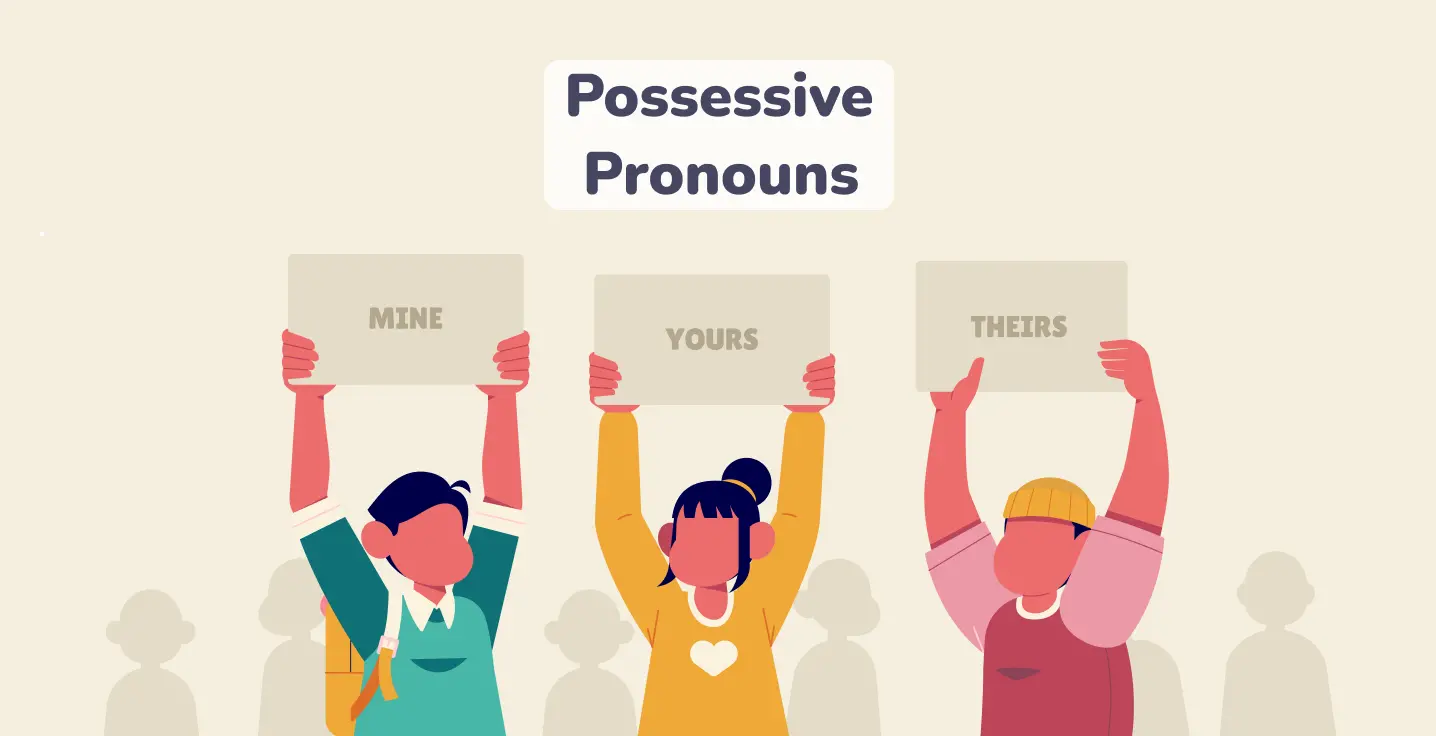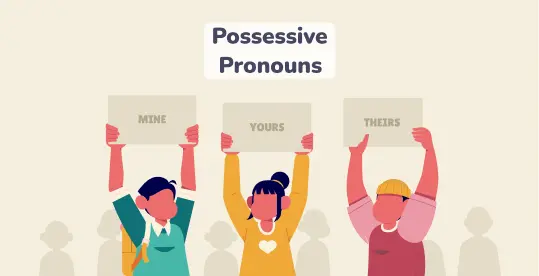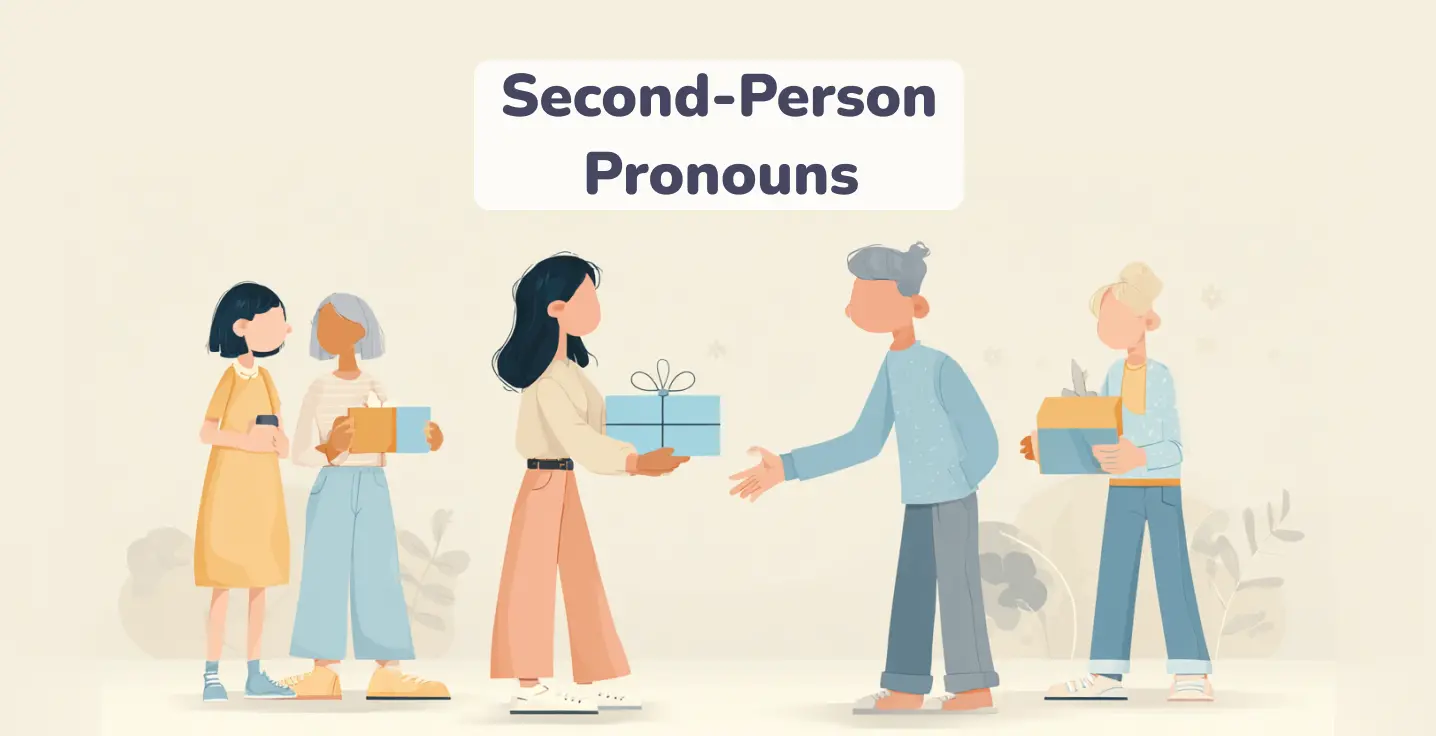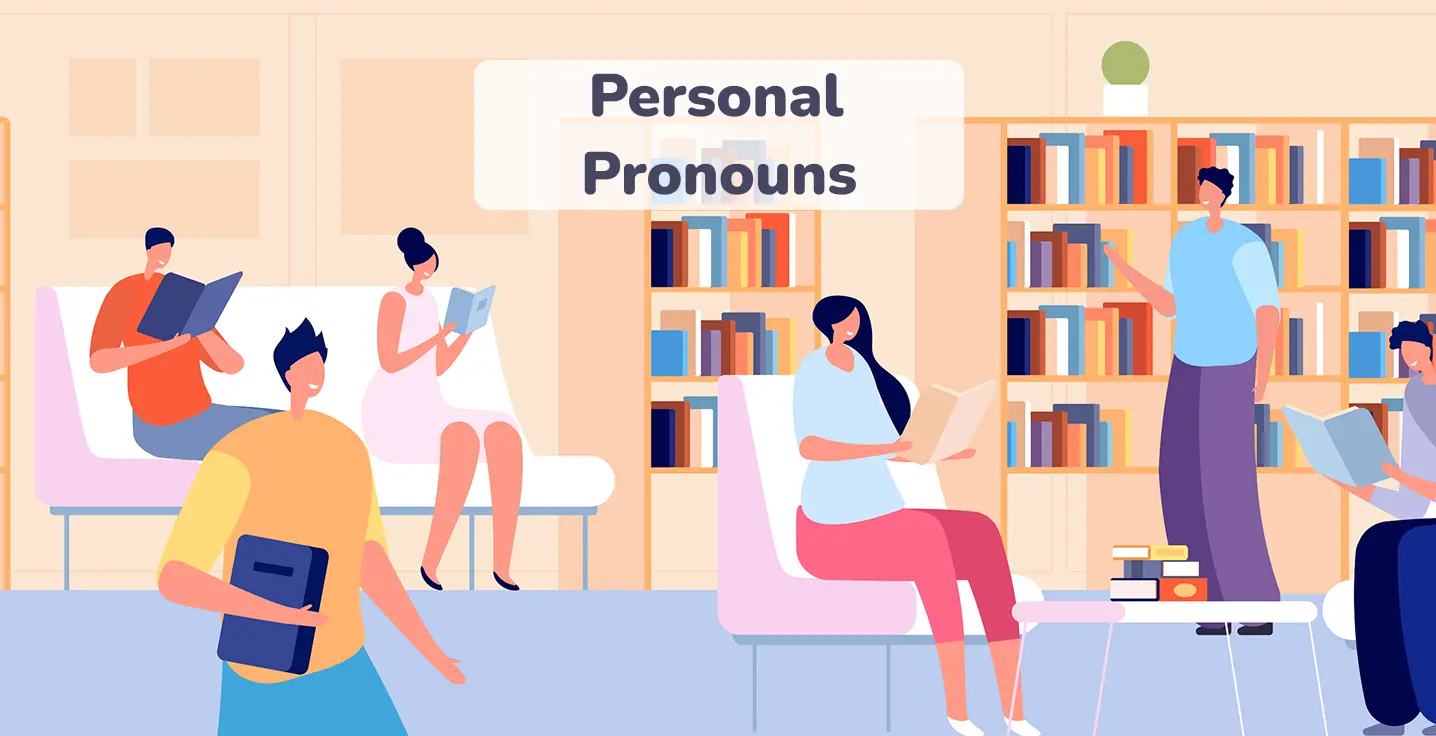What is a possessive pronoun?
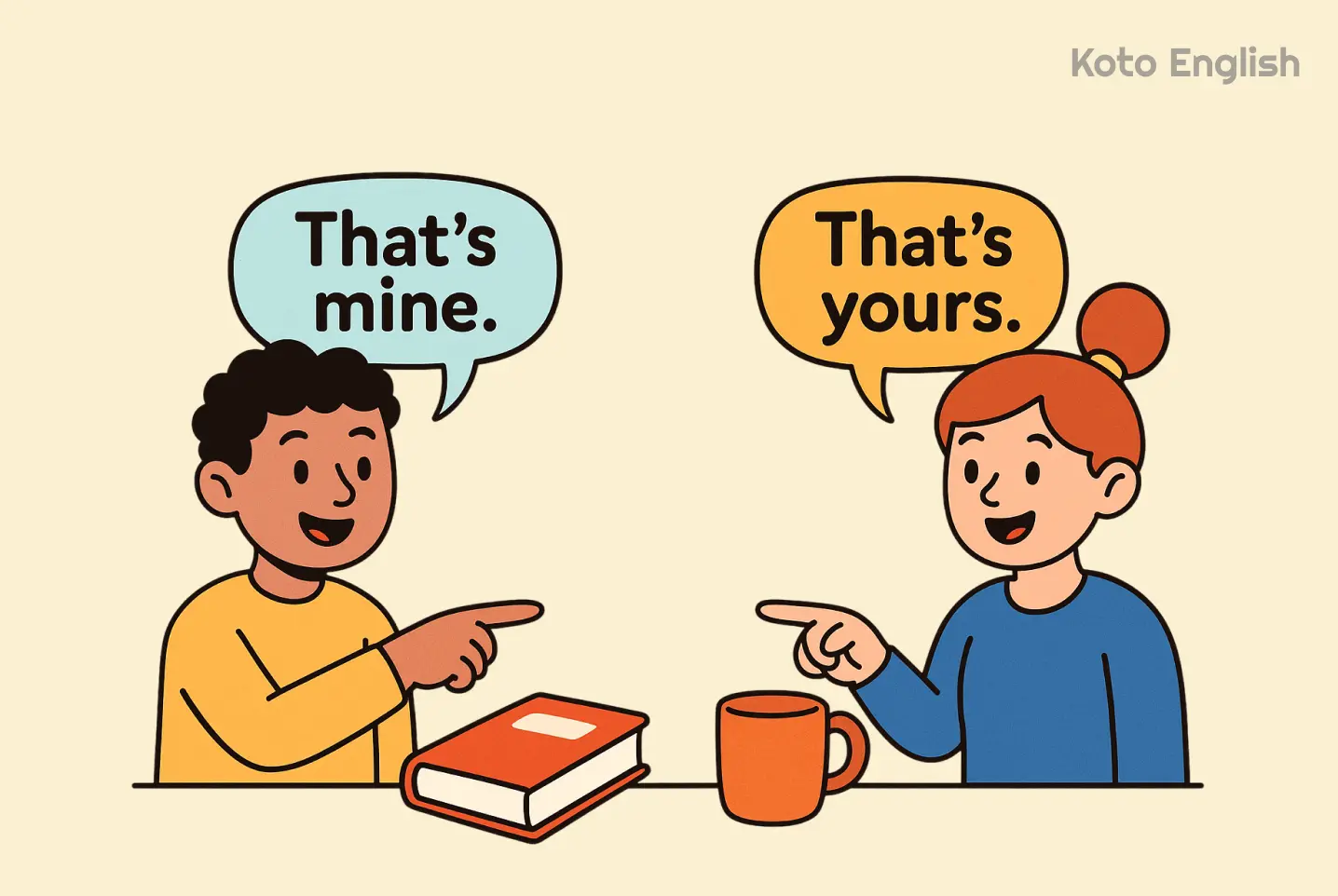
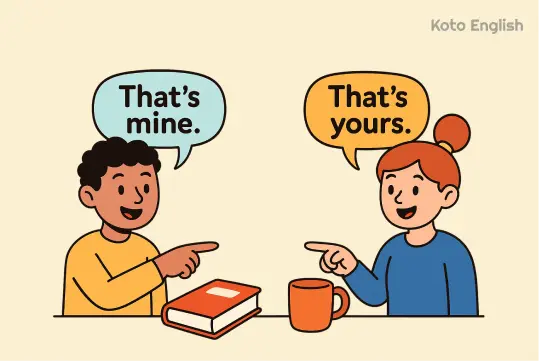
A possessive pronoun is the friend who finishes your sentences for you and does it better. Instead of repeating my shoes and your shoes, you just say, Those are mine. These are yours. Fewer words, same message, more style.
These handy pronouns help your speech sound more natural and your writing less robotic. They’re all about ownership, without the repetition.
So when a noun and its owner have already been introduced, a possessive pronoun steps in and says, “I’ve got this.”
List of possessive pronouns
So, what are possessive pronouns? If you’ve ever wondered about that and how to use them correctly, this table has your back. Use it as your cheat sheet, because ownership in grammar shouldn’t be a guessing game.
| Person | Singular | Plural |
|---|---|---|
| First person |
mine
|
ours
|
| Second person |
yours
|
yours
|
| Third person |
his / hers / its*
|
theirs
|
Note that “Its” is technically a possessive pronoun, but it’s rarely used alone in modern English. Most of the time, its functions as a possessive adjective (e.g., its tail, not the tail is its). Unless you’re writing poetry for a robot dog, you probably won’t need its as a standalone pronoun.
These words always stand alone — they replace nouns instead of describing them. So you’d say, This phone is mine, not This is my phone (that’s using a possessive adjective). Different roles, same idea: someone owns something.
Level up your English with Koto!
How to use them correctly
All possessive pronouns show ownership in a neat and simple way, replacing nouns so you don’t have to repeat yourself. Words like mine, yours, and hers stand on their own and make your sentences less bulky.
Proper usage of possessive pronouns will make the flow of your writing easy, as well as speaking. E.g this is my jacket and that is your jacket is changed to this is mine and that is yours. It is time-saving and more natural.
Nonetheless, you should be aware of the rules to prevent the pitfalls. When you learn to incorporate possessive pronouns in your sentences, you will develop a better and tidier command of the English language.
Sentence structure and examples
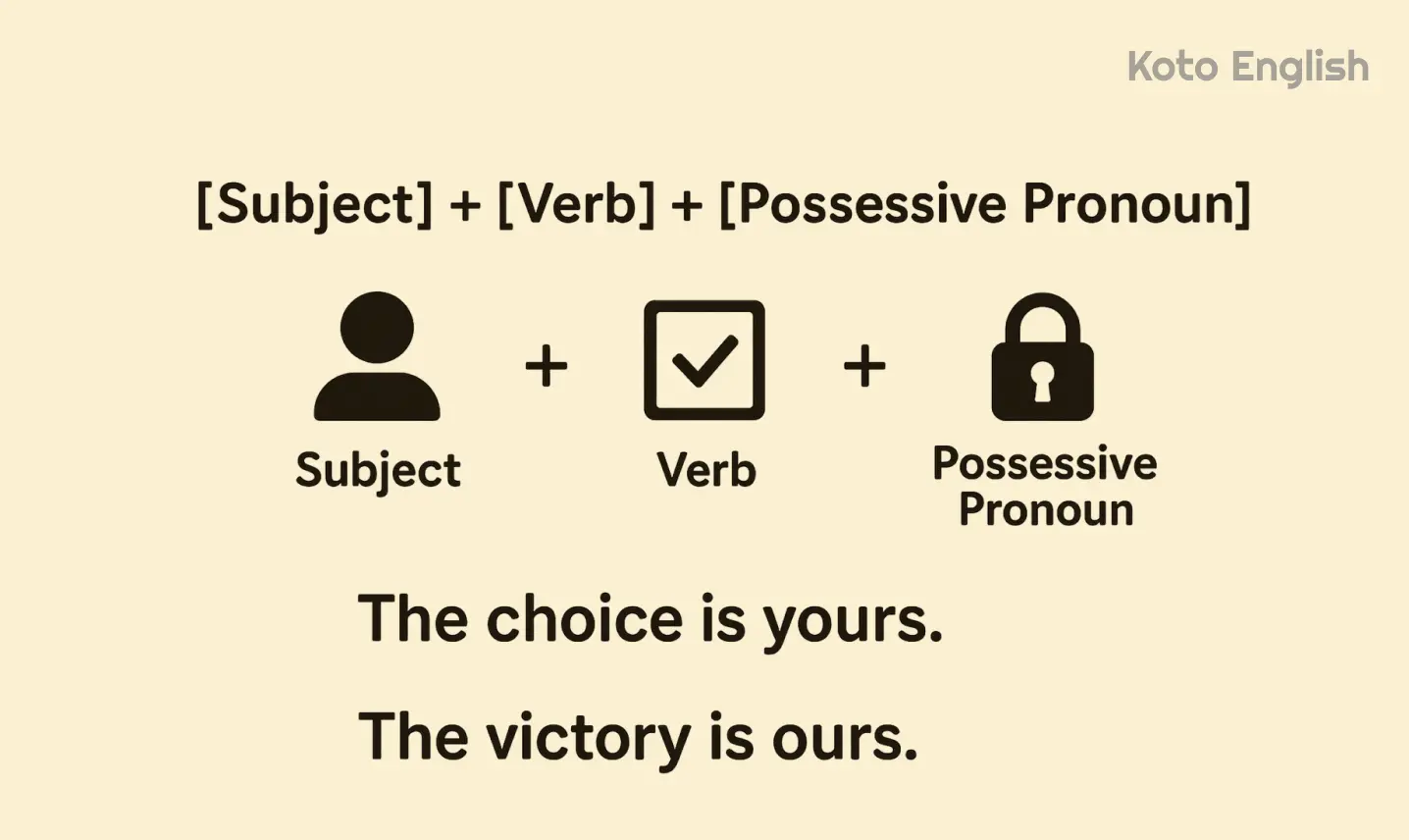
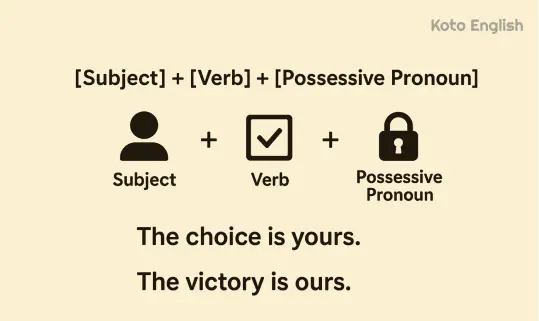
A possessive pronoun in English appears on its own in a sentence: it occupies the position normally filled, not by the noun it describes but by the object position it expresses. That is the difference between possessive pronouns (mine, yours, his, hers, ours, theirs) and possessive adjectives (my, your, his, her, our, their).
Basic structure:
[Subject] + [verb] + [possessive pronoun]
Examples of possessive pronouns:
A quick test: remove the noun. If the meaning survives, you have a pronoun. If it doesn’t, it was an adjective.
Adjective:
Pronoun: The brilliant idea was
Possessive adjectives always need their noun sidekick, but grasping the possessive pronoun meaning reveals how they stand strong all on their own.
Also, remember that possessive pronouns can appear in different parts of a sentence:
At the end of a sentence:
Before a verb like “is” or “are”:
As the subject itself:
Getting possessive pronouns right gives your English a polished, confident feel. Overusing nouns makes sentences heavy; skipping them when needed causes confusion. Possessive pronouns create balance by keeping your message short but complete.
With time, you’ll replace repetitive phrases without thinking. That’s mine will slip out naturally instead of That is my bag, and you’ll know these small words are working for you.
Possessive pronouns vs. possessive adjectives
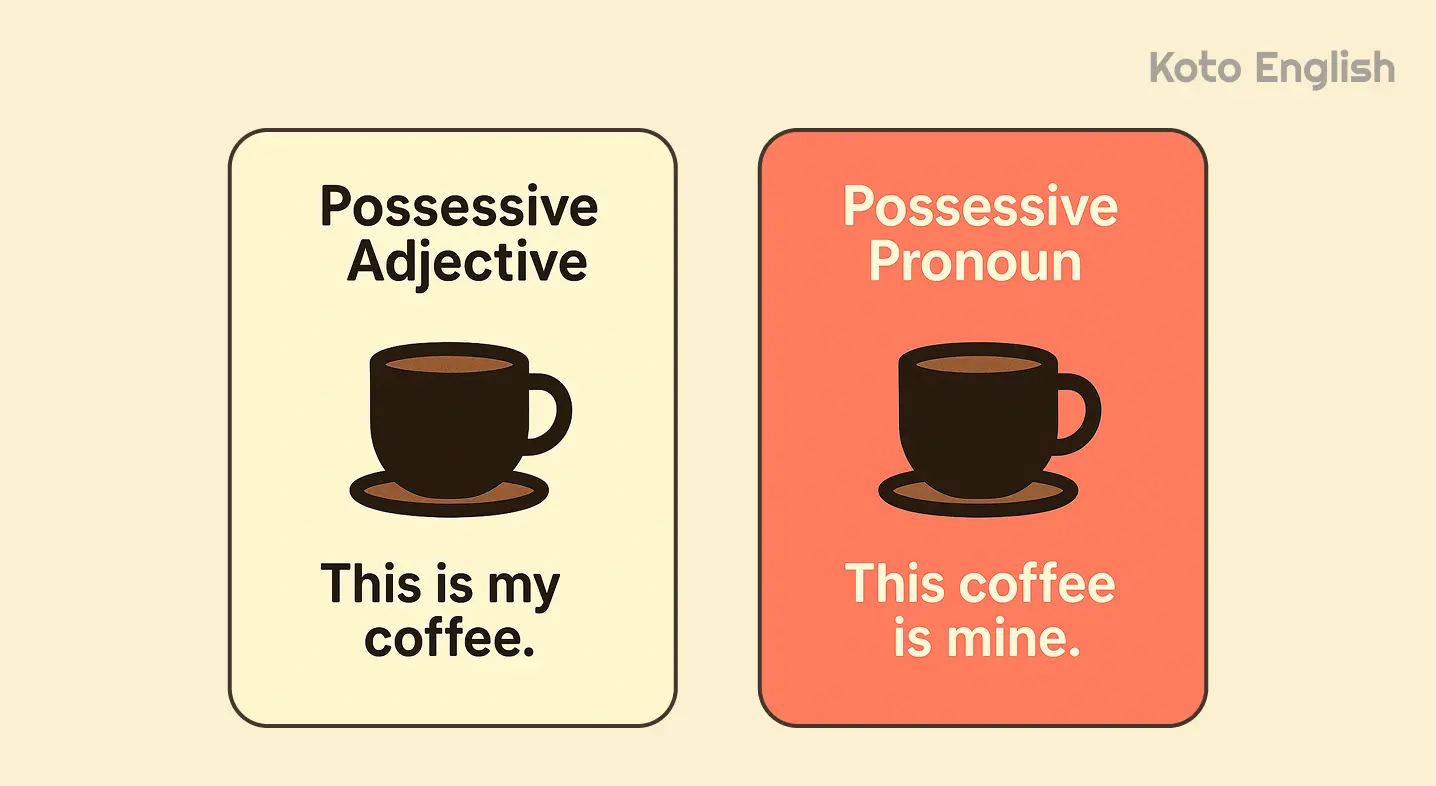
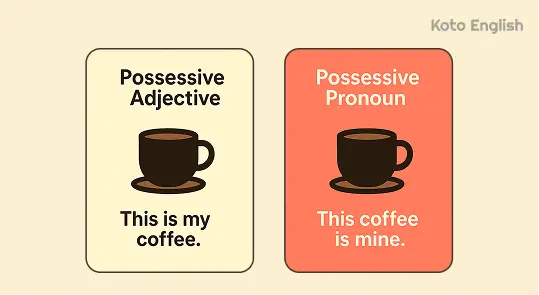
If English possessive pronouns and possessive adjectives were people, they’d be siblings who share a family resemblance but have completely different personalities. They both talk about ownership, but they don’t show up in the same situations in the same way.
-
Possessive adjectives are like the plus-ones at a party — they never arrive alone. They always bring a noun with them. You’ll see them in words like: my, your, his, her, its, our, their
That ismy coffee. (The word “my” is glued to the noun “coffee.” Without “coffee,” “my” can’t stand by itself.)
-
Possessive pronouns, on the other hand, are lone wolves. They don’t need a noun right after them — they are the noun’s replacement. Their lineup looks like this: mine, yours, his, hers, its, ours, theirs
That coffee ismine . (No noun follows “mine.” It works solo, and we still know who owns the coffee.)
| Possessive adjective | Possessive pronoun |
|---|---|
|
This is
|
The last slice of pizza is
|
|
I changed
|
The new Netflix password is
|
|
He scratched
|
The winning ticket is
|
|
She posted
|
The vacation photos are
|
|
The dog chased
|
The tail is
|
|
We lost
|
The front-row seats are
|
|
They left
|
The socks on the couch are
|
|
I forgot
|
The cold coffee on the bus seat is
|
|
Please clean
|
The browser history is
|
|
We fixed
|
The working Wi-Fi is
|
The possessive pronoun definition sheds light on its correct use. Why does the difference matter? Mixing them up can make sentences sound clunky or wrong. Compare:
We will discuss other typical mistakes more precisely in our article later.
Imagine a possessive adjective as someone pointing to a thing and saying, “This is my book.”
They need the thing there in the sentence.
A possessive pronoun says: This is
It’s the difference between holding the noun’s hand and standing confidently alone.
When in doubt, look at what comes next.
- Noun in sight? Go with my, your, his, her, its, our, their.
- No noun following? Use mine, yours, his, hers, its, ours, theirs.
After a bit of practice, the change will be instant: This is
Quick Recap:
- Possessive adjectives (my, your, his, her, its, our, their) — always come before a noun: This is
my book. - Possessive pronouns (mine, yours, his, hers, its, ours, theirs) — replace the noun and stand alone: The book is
mine .
Tip: If a noun follows immediately, it’s an adjective. If there’s no noun, it’s a pronoun.
Common mistakes to avoid
Ownership words like possessive pronouns might seem harmless, but place them wrong and they cause real headaches. Let’s dive into the top mistakes and how to sidestep them smoothly.
Mistake 1: Using possessive pronouns after a noun
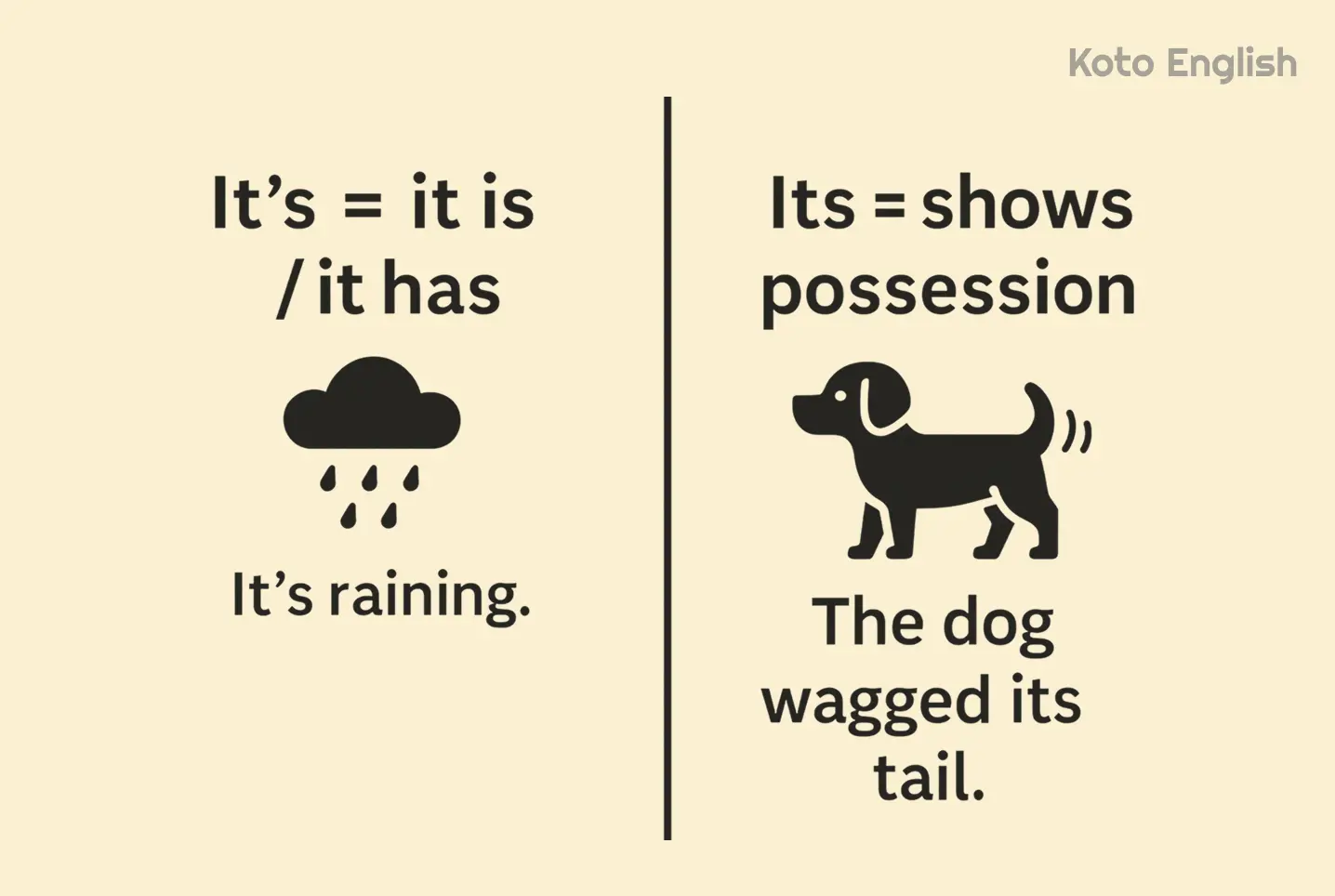
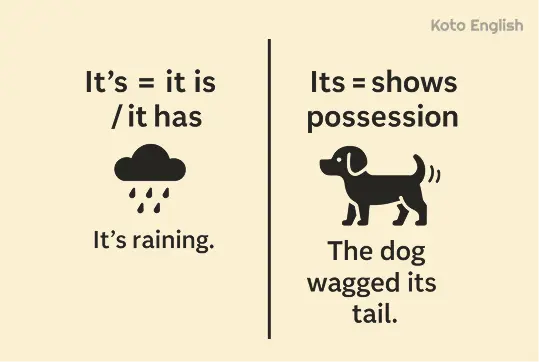
One of the most frequent errors is trying to put a possessive pronoun right after a noun, like slapping a sticker where it doesn’t belong. Possessive pronouns stand instead of a noun; they don’t follow one. When you want to keep the noun, you need a possessive adjective instead. Check out these possessive pronouns examples:
|
This is mine phone.
|
This is my phone.
|
|
That bag is their.
|
That bag is theirs.
|
Mistake 2: Confusing “its” and “it’s”
Even the best get tangled in this classic apostrophe puzzle. Try this quick test: if you can say “it is” or “it has” in the sentence, you want it’s. If it shows possession, then its is the right choice.
|
Its raining outside today.
|
It’s raining outside today.
|
|
The cat hid in it’s bed.
|
The cat hid in its bed.
|
Mistake 3: Mixing possessive pronouns and adjectives
Sometimes, there is the issue of the use of a possessive pronoun as an adjective or a possessive pronoun as an adjective. Each of the two has its usages but when mixed up, sentences become not only awkward, but also incorrect. Remember the possessive pronouns definition in order not to lose the way.
|
That is mine coat.
|
That is my coat.
|
|
The choice is our’s.
|
The choice is ours.
|
Tip: Notice how adding an apostrophe to possessive pronouns like “ours” or “yours” is a common but incorrect habit. These pronouns never take apostrophes.
Mistake 4: Forgetting agreement in number and person
Possessive pronouns and adjectives must match the person (first, second, third) and number (singular, plural) of the noun they replace or modify. For example:
|
These ideas are your — you should share them.
|
These ideas are yours — you should share them.
|
|
This bag is our, but that one is your.
|
This seat is ours, but that one is yours.
|
Exception:
Tiny but powerful, possessive pronouns help cut through wordiness and boost clarity. With a bit of focus, you’ll soon use them with precision and confidence.
Summary and tips
Though small, possessive pronouns carry nuances that elevate your writing. When the possessive pronouns’ meaning becomes clear, using mine, yours, his, hers, ours, and theirs instead of repeating nouns feels effortless. Here are some quick reminders:
- Use possessive pronouns to replace a noun plus a possessive adjective, avoiding repetition.
- They always stand alone and never directly precede a noun.
- Don’t add apostrophes to possessive pronouns — they never take one.
- Practice spotting the difference between possessive pronouns and adjectives like my, your, or their.
Possessive pronouns are small words with a big role. Mastery comes with consistent practice and paying attention to context. Keep practicing, and soon these pronouns will fit smoothly into your everyday English, making your communication polished and confident.
Enjoy personalized learning!
Possessive pronoun FAQ
My is a possessive adjective used before a noun to show ownership, as in “my bed.” Mine is a possessive pronoun that replaces the noun altogether, like in “That bed is mine.”
My
- Type: Possessive adjective
- Use: Comes before a noun to show ownership
Mine
- Type: Possessive pronoun
- Use: Replaces the noun phrase entirely
You can practise this distinction with a possessive pronouns worksheet to reinforce the rules.
No, its is a possessive adjective, not a pronoun. It shows ownership and always modifies a noun, as in “The dog wagged its tail.” It never stands alone to replace a noun. Unlike mine or yours, which are possessive pronouns, its must always be followed by the thing owned.
No, possessive pronouns never appear directly before nouns. They replace the noun phrase completely. For example, you say The surprise party was hers, and everyone loved it. Not The surprise party was her party. (unnecessary repetition)
Yes, possessive pronouns list (mine, yours, his, hers, ours, and theirs) functions the same way in both British and American English. The rules and usage remain consistent across these varieties, so you don’t have to worry about regional differences when it comes to possessive pronouns.
In such a wide topic as nouns for a group of individuals, there is a lot of space for imagination, so let’s consider some of the most extraordinary nouns you can meet in literature, everyday communication, music, and so on:
For example, you can find a squad, a flock (for tourists), a giggle for a few girls, never thriving for jugglers, a clutch for wrestlers (and suno as well), and more. You can also use the word “huddle” when talking about teenagers, and it may sound a bit uncommon for those who have just started learning this topic.



